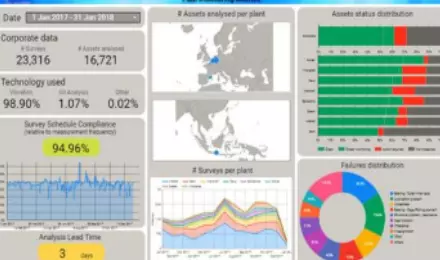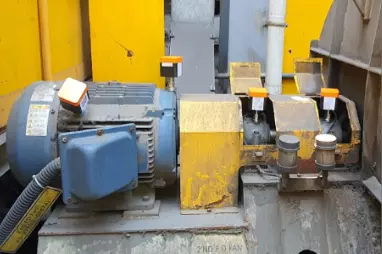Did you know that 80% of mechanical equipment breakdowns are linked with bad lubrication?
For maintenance managers and plant operators in water, energy, waste, steel, and pharmaceutical facilities, this statistic reveals a critical truth: most equipment failures are preventable. Yet unplanned shutdowns continue to cause lost production, regulatory complications, and spiraling repair bills.
The challenge is clear: How can organizations detect lubrication issues and mechanical problems before they escalate into costly equipment failure?
Hubgrade Asset Maintenance combines smart vibration sensors with continuous remote analysis by specialized vibration experts to detect issues in critical rotating equipment long before they become breakdowns. This proactive approach eliminates unplanned shutdowns, increases safety, and optimizes maintenance costs.
Key benefits of predictive vibration monitoring
- Prevent costly downtime through early detection before equipment failure
- Increase overall safety by identifying critical equipment risks
- Decrease maintenance costs with targeted, condition-based interventions
- Increase equipment performance through expert analysis of lubrication, balancing, and bearings
- Expert root cause diagnostics by specialized vibration analysts
- Proven results across water, energy, waste, steel, and pharmaceutical sectors in Korea
The challenge: Why traditional maintenance fails
Industrial sites operate hundreds of critical assets, pumps, ID fans, cooling fans, turbines, around the clock. Maintenance teams face three persistent challenges:
1. Reactive maintenance leads to costly, preventable failures
Traditional maintenance schedules rely on fixed intervals or reactive repairs after problems occur. This approach leads to unnecessary overhauls, wasted resources, and missed early warning signs of failure. The result? Equipment breakdowns that could have been prevented with timely detection of issues like lubrication deficiencies, imbalance, or bearing wear.
2. Unplanned shutdowns cascade into severe operational and financial losses
A single critical equipment failure can halt production lines, disrupt water treatment processes, compromise pharmaceutical quality, or shut down waste treatment operations. The financial and reputational impact is severe - especially when failures are traced to preventable causes like inadequate lubrication or undetected mechanical deterioration.
3. Vibration analysis requires specialized expertise most facilities don't have
Vibration spectrum analysis is a highly complex and specialized task. Most facilities lack the internal resources to interpret vibration data, perform root cause analysis, and recommend targeted interventions. Regular vibration measurements alone cannot provide proactive insights - the real value comes from expert analysis that identifies whether issues stem from lubrication problems, balancing issues, or bearing defects. This skills gap results in delayed responses, recurring issues, and missed opportunities to prevent equipment damage.

The solution: How Hubgrade Asset Maintenance works
Smart sensors + Expert analysis
The system deploys smart vibration sensors (4 for simple equipment, 8 for complex turbines) on critical rotating machinery. These sensors continuously collect high-resolution data, with the AI system immediately operational upon installation.
Collected data is transmitted for remote analysis by specialized vibration experts with advanced expertise in vibration spectrum analysis, a highly complex task requiring years of field experience most facilities don't have in-house.
What experts detect:
- Lubrication deficiencies or excess - a leading cause of equipment failure
- Imbalance and misalignment - before they cause bearing damage
- Bearing wear and early-stage faults - weeks or months before failure
Multi-level notification system:
- Serious alerts - requiring immediate intervention
- Concerns - issues needing attention but not yet critical
- Recommendations - optimization opportunities
This enables maintenance teams to prioritize interventions based on real risk, allocating resources where they'll have the greatest impact.
Proven results: Korean case studies
KleanNara: Optimizing boiler reliability in the paper & pulp sector

KleanNara, a paper and pulp industry client in Cheongju, South Korea, operates SRF boiler facilities producing 42.5T/h of steam across two units. The installation of Hubgrade Asset
Maintenance on induced draft (ID) fans transformed their maintenance approach.
The continuous vibration monitoring system provided real-time insights into equipment health, enabling early detection of lubrication issues and bearing wear before they could impact operations.
Results achieved:
- Optimized critical facility nondisruptive operations and maintenance costs
- Avoided unplanned shutdowns through early problem detection
- Improved overall safety through continuous equipment health monitoring
By moving from reactive to predictive maintenance, KleanNara gained the ability to address mechanical issues before they escalated into equipment failures.
Uniken: Enhancing hazardous waste facility uptime

Uniken operates a comprehensive hazardous waste treatment facility in Ulsan, South Korea, including two incinerators (processing 13,000 T/y and 35,000 T/y combined), liquid hazardous
waste treatment (12,000 T/y), and industrial wastewater treatment (153,000 T/y)The facility deployed smart vibration sensors with remote expert analysis on critical ID fans. The specialized vibration diagnosticians identified early-stage faults and lubrication deficiencies before they could escalate into equipment failures.
Results achieved:
- Maintained continuous operations through proactive issue detection
- Enhanced operational safety by identifying equipment risks early
- Decreased maintenance costs through targeted, condition-based interventions
- Enhanced equipment performance by maintaining optimal operating conditions
The expert analysis capability proved particularly valuable in this complex facility, where multiple critical systems operate continuously and unplanned shutdowns would have severe operational and regulatory consequences.
Investment and scalability
Transparent, asset-based pricing
Subscription-based model per asset per month, with volume discounts. Includes sensors, expert analysis, notifications, and training.
Proven scalability in Korea
- 10 equipment units deployed in 2024
- Expansion to 30+ units planned for 2025
- 8-week sensor delivery, AI immediately operational
- Successfully implemented at KleanNara, Uniken, and other leading Korean sites
Four step implementation
- Asset audit - Identify critical equipment for monitoring
- Sensor installation - Deploy 4-8 sensors per asset (8-week delivery)
- Immediate activation - AI operational instantly; team training begins
- Continuous optimization - Expert analysis with multi-level notifications
Transform maintenance strategy
The evidence is clear: 80% of mechanical equipment breakdowns stem from preventable issues like bad lubrication. The question isn't whether your equipment will develop problems, it's whether you'll detect them in time.
Hubgrade Asset Maintenance delivers:
- Prevention of unplanned shutdowns and production losses
- Decreased maintenance costs through targeted interventions
- Boosted equipment performance and operational safety
- Optimized operations across all critical rotating assets

